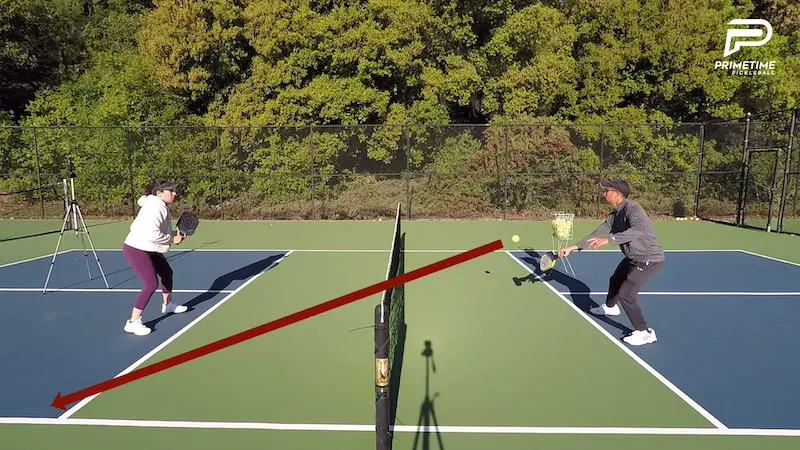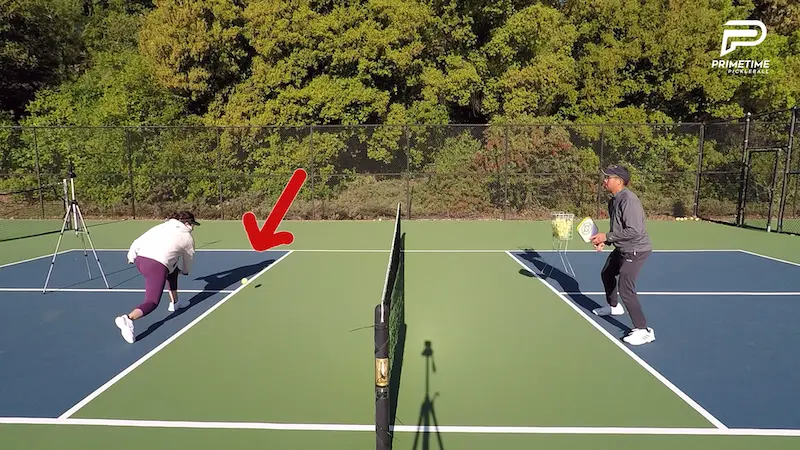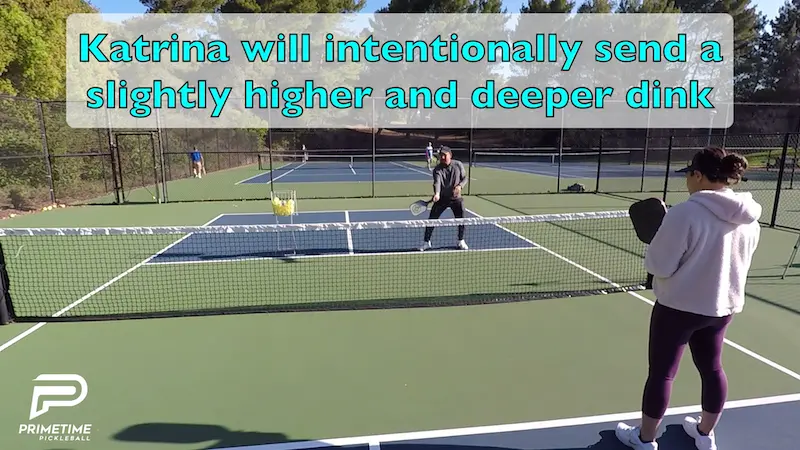In this blog we’re going to go over the dink angle volley attack.
We’re going to describe to you an example of that first and then after that we’re going to break it down.
What we’re going to do is that we’re actually at the non-volley zone line trying to set up an attackable ball.
Instead of hitting the ball really hard right at our opponent, what we’re doing is we’re actually rolling it in an off-pace speed right to their feet, in the corner, wide off the court.
There’s a couple of reasons why this is effective.
The first reason is that usually your opponent, if they’re dinking and they see a ball that can get attacked, they’re going to be in defensive mode so they’re going to probably put their paddle around their chest/upper abdomen area to defend a very fast ball.
Since it’s an off-pace attack they’re really ready for anything in this chest/upper abdomen area but they’re not expecting a ball to roll at their feet.
They’re going to have to go from the paddle out in front of them in the chest/abdomen area to getting low, down at their feet and they’re going to have to hit that ball up.
This is why an off-pace attack is good.
This is a breakdown of how you do it in order to execute this shot.
The first step is to be up at the non-volley zone line and generate an attackable shot that comes a bit high. Net height or even a bit lower will work. This is because you can put some topspin roll on it.
You also need for the shot you receive to be more towards the middle on your side so that you have the necessary angle to be able to hit that off-pace swinging roll volley in the corner of the kitchen or a tad deeper beyond the kitchen and still towards the sideline.

It’s ideal that the shot comes out of the middle from your opponent so that you have them moved over towards the middle of the court and out of position which will make covering the next shot that will come back from you even tougher for them.
To generate this particular ball that you want to receive, you will be wanting to work your opponent around the kitchen with various dinks (towards the sideline, towards their body, and towards the middle) with the idea that when you send dinks more towards the middle you are actively looking for a shot to come back that will meet the criteria for you to execute the short angle dink volley roll.

In order to execute the stroke, once you do get the ball you want, you will let your paddle head drop behind and under the ball. You must also have a laid back wrist when doing so.
The paddle head will drop beneath your wrist. The swing on this shot will be accomplished mostly by rolling the forearm.
Contrary to what it may seem like in real time you will not use that much wrist, only a little, and you’re mostly rotating that forearm.
It’s an off-pace shot, meaning not very fast. It’s a placement shot rather than a power shot therefore your shoulder will come through somewhat but not all the way through like when you were doing a full power swinging volley.
One way you can practice this is to line up with your opponent on opposite sides of the court.
You’re going to dink towards your opponents backhand. You’re going to set it up dinking straight on and then when they send you a deeper dink or or a little bit of a higher dink, you’re going to choose to practice this dink angle attacking volley.

You will find you have different options. Remember the contact point of this ball has to be at net level or just a little bit lower and is attackable. If you wanted to you could actually speed that ball up really hard to your opponents body but instead you’re going to do an off-pace attack.
In a practice scenario you would dink to your opponents backhand and they would send it back to your forehand. From the middle of the court you will hit your angled attack dink to the their forehand towards the sideline. Your opponent won’t expect it.
Right after you hit that angled dink shot you should be getting ready for the return down the line because usually if your opponent gets stretched out wide on that angled dink it will typically come down the line or close to that area as it will be hard for them to get it back in the middle of the court.
This is a really good shot to try go out there and try it with a friend.
It’s good shot to have in your bag of tricks. You don’t always want to hit hard.
Hitting these off-pace and angled shots are really great because your opponent is not going to know what what to expect.